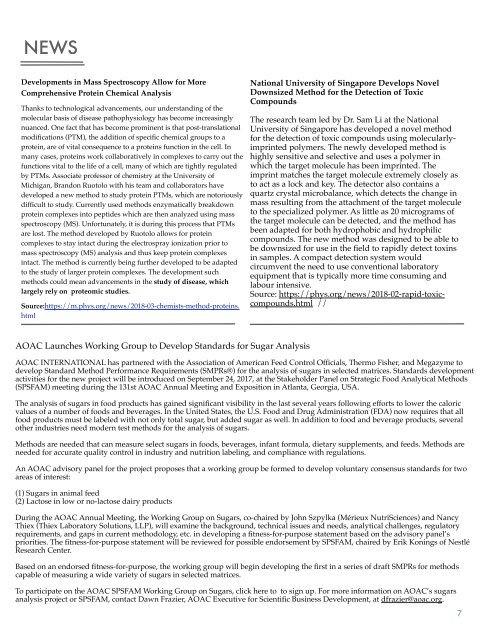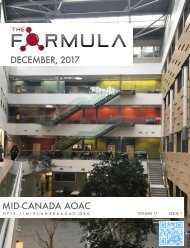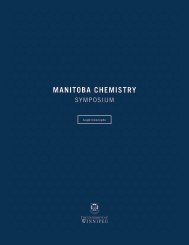Formula_Volume_18_Iissue 1
You also want an ePaper? Increase the reach of your titles
YUMPU automatically turns print PDFs into web optimized ePapers that Google loves.
NEWS<br />
Developments in Mass Spectroscopy Allow for More<br />
Comprehensive Protein Chemical Analysis<br />
Thanks to technological advancements, our understanding of the<br />
molecular basis of disease pathophysiology has become increasingly<br />
nuanced. One fact that has become prominent is that post-translational<br />
modifications (PTM), the addition of specific chemical groups to a<br />
protein, are of vital consequence to a proteins function in the cell. In<br />
many cases, proteins work collaboratively in complexes to carry out the<br />
functions vital to the life of a cell, many of which are tightly regulated<br />
by PTMs. Associate professor of chemistry at the University of<br />
Michigan, Brandon Ruotolo with his team and collaborators have<br />
developed a new method to study protein PTMs, which are notoriously<br />
difficult to study. Currently used methods enzymatically breakdown<br />
protein complexes into peptides which are then analyzed using mass<br />
spectroscopy (MS). Unfortunately, it is during this process that PTMs<br />
are lost. The method developed by Ruotolo allows for protein<br />
complexes to stay intact during the electrospray ionization prior to<br />
mass spectroscopy (MS) analysis and thus keep protein complexes<br />
intact. The method is currently being further developed to be adapted<br />
to the study of larger protein complexes. The development such<br />
methods could mean advancements in the study of disease, which<br />
largely rely on proteomic studies.<br />
Source:https://m.phys.org/news/20<strong>18</strong>-03-chemists-method-proteins.<br />
html<br />
National University of Singapore Develops Novel<br />
Downsized Method for the Detection of Toxic<br />
Compounds<br />
The research team led by Dr. Sam Li at the National<br />
University of Singapore has developed a novel method<br />
for the detection of toxic compounds using molecularlyimprinted<br />
polymers. The newly developed method is<br />
highly sensitive and selective and uses a polymer in<br />
which the target molecule has been imprinted. The<br />
imprint matches the target molecule extremely closely as<br />
to act as a lock and key. The detector also contains a<br />
quartz crystal microbalance, which detects the change in<br />
mass resulting from the attachment of the target molecule<br />
to the specialized polymer. As little as 20 micrograms of<br />
the target molecule can be detected, and the method has<br />
been adapted for both hydrophobic and hydrophilic<br />
compounds. The new method was designed to be able to<br />
be downsized for use in the field to rapidly detect toxins<br />
in samples. A compact detection system would<br />
circumvent the need to use conventional laboratory<br />
equipment that is typically more time consuming and<br />
labour intensive.<br />
Source: https://phys.org/news/20<strong>18</strong>-02-rapid-toxiccompounds.html<br />
//<br />
AOAC Launches Working Group to Develop Standards for Sugar Analysis<br />
AOAC INTERNATIONAL has partnered with the Association of American Feed Control Officials, Thermo Fisher, and Megazyme to<br />
develop Standard Method Performance Requirements (SMPRs®) for the analysis of sugars in selected matrices. Standards development<br />
activities for the new project will be introduced on September 24, 2017, at the Stakeholder Panel on Strategic Food Analytical Methods<br />
(SPSFAM) meeting during the 131st AOAC Annual Meeting and Exposition in Atlanta, Georgia, USA.<br />
The analysis of sugars in food products has gained significant visibility in the last several years following efforts to lower the caloric<br />
values of a number of foods and beverages. In the United States, the U.S. Food and Drug Administration (FDA) now requires that all<br />
food products must be labeled with not only total sugar, but added sugar as well. In addition to food and beverage products, several<br />
other industries need modern test methods for the analysis of sugars.<br />
Methods are needed that can measure select sugars in foods, beverages, infant formula, dietary supplements, and feeds. Methods are<br />
needed for accurate quality control in industry and nutrition labeling, and compliance with regulations.<br />
An AOAC advisory panel for the project proposes that a working group be formed to develop voluntary consensus standards for two<br />
areas of interest:<br />
(1) Sugars in animal feed<br />
(2) Lactose in low or no-lactose dairy products<br />
During the AOAC Annual Meeting, the Working Group on Sugars, co-chaired by John Szpylka (Mérieux NutriSciences) and Nancy<br />
Thiex (Thiex Laboratory Solutions, LLP), will examine the background, technical issues and needs, analytical challenges, regulatory<br />
requirements, and gaps in current methodology, etc. in developing a fitness-for-purpose statement based on the advisory panel’s<br />
priorities. The fitness-for-purpose statement will be reviewed for possible endorsement by SPSFAM, chaired by Erik Konings of Nestlé<br />
Research Center.<br />
Based on an endorsed fitness-for-purpose, the working group will begin developing the first in a series of draft SMPRs for methods<br />
capable of measuring a wide variety of sugars in selected matrices.<br />
To participate on the AOAC SPSFAM Working Group on Sugars, click here to to sign up. For more information on AOAC’s sugars<br />
analysis project or SPSFAM, contact Dawn Frazier, AOAC Executive for Scientific Business Development, at dfrazier@aoac.org.<br />
7




